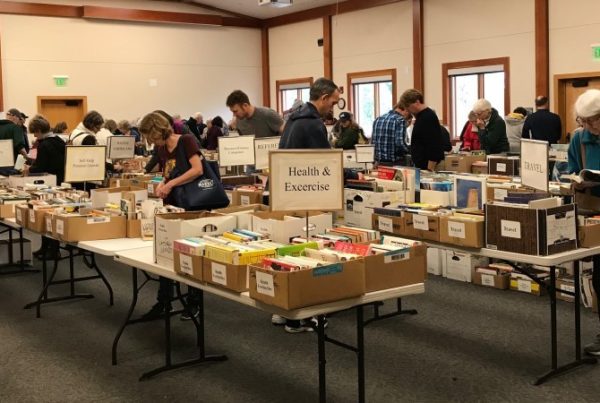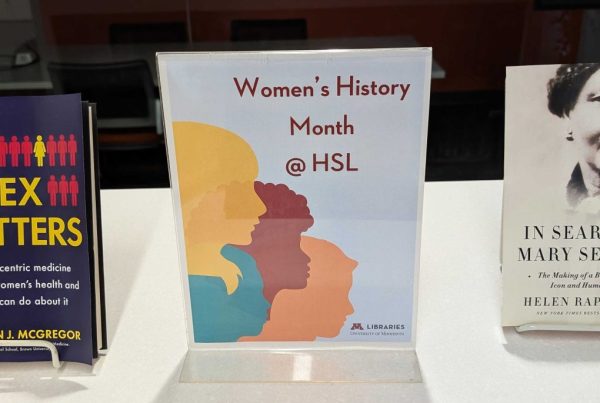by Erinn Aspinall
Health sciences librarians join their University colleagues in their academic pursuits. In the case of librarians at the Health Sciences Libraries (HSL), this means actively contributing to their community and their profession.
Much of the time, HSL librarians are busy connecting with students, faculty, and staff in the Academic Health Center to support their information needs. HSL librarians are also expected to meet a rigorous promotion schedule that requires committee involvement, research and publication, and participation in professional organizations.
These efforts are illustrated by the recent work of the HSL’s Jim Beattie and Janice Jaguszewski, whose contributions will have an important impact on their professional community and future practice.
Google, information, residents
The image below depicts the research of our Clinical Librarian, Jim Beattie. Beattie is one of two liaisons at the Bio-Medical Library serving the School of Medicine. His work as a librarian in a clinical context always has him engaged in the health information seeking process.

Jim Beattie and his research on information seeking strategies of residents.
Beattie’s most recent research relates to the information seeking process followed by residents. In the study, “Should we Google it? Resource use by internal medicine residents for point-of-care clinical decision making” published in the June issue of Academic Medicine, Beattie and his co-authors explore how residents find answers to their clinical questions (1).
This research was recently highlighted in American Medical News (2). In this summary, the study’s lead author, Dr. Alisa Duran-Nelson, shares that the impetus for the research came when she challenged a resident to find an article faster using Google Scholar verses her traditional approach of searching PubMed.
In a side-by-side comparison, the Google Scholar approach was found to be the fastest. “Sure enough, he ends up pulling the article up within about 10 seconds, and I had just started putting in my [medical search] headings in PubMed. I was just blown away by this“ said Dr. Duran-Nelson (2).
The study’s results came from surveying 299 residents on the search methods used at the point-of-care to inform clinical decision-making. Of the 167 residents (65%) who responded to the survey, a full 85% indicated that UpToDate (a licensed clinical decision support resource) was their go-to resource for finding information at the point-of-care.
The use of UpToDate was closely followed by Google, which was used by 63% of respondents. Why is this finding important? As Beattie states, “Although sites like Google and Wikipedia are good at producing information quickly, they have a stigma within the medical profession associated with their use because of the unreliability of what comes up compared with a scholarly search ” (2).
This unreliability has to be balanced with limited resources, namely limited time. For librarians like Beattie, this indicates a need to not only educate residents about alternate resources, but also to teach to the preferred tools. This will help residents find the best evidence to support their clinical decision making and care for their patients.
Library, research, liaison, roles
Janice Jaguszewski, Health Sciences Libraries Director, has also been busy completing research in support of academic librarianship. She and her colleague Karen Williams served as the co-authors of the recently published report, “Transforming Liaison Roles in Research Libraries.” This report is part of the Association of Research Libraries (ARL) New Roles for New Times publicationlication series.

Janice Jaguszewski and her research on new roles for librarians.
The Liaison model of librarianship, where librarians are assigned to serve a particular school or department, has existed in some form for well over a decade. However, as Jaguszewski found in her interviews with administrators at five ARL libraries, the conceptualization of the liaison librarian role is constantly evolving.
Within the six trends identified in this report, an interesting discovery is the movement towards engaging “superliaisons” who have specialized expertise and can serve librarian colleagues, colleges, and even entire universities with their unique skill set.
What might a superliaison look like within the Health Sciences Libraries? Jaguszewski Is already imagining this next evolution of liaison librarianship and is currently recruiting a librarian who will have expertise in informatics and data services to support these growing needs within the Academic Health Center.
Seeing the bigger picture
The work of Beattie and Jaguszewski illustrates a few of the many ways HSL librarians bring value to their profession. In the past year, HSL librarians have presented papers at professional conferences, served on editorial boards, and have had representation on committees within the Academic Health Center, University Libraries, and professional organizations.
HSL librarians are always interested in engaging in academic pursuits to further their profession, for it is through these activities that they can better serve their community.
For more information, contact:
Jim Beattie, MLIS
Medical School Liaison
jbeattie@umn.edu
Janice Jaguszewski, MS
Director, Health Sciences Libraries
j-jagu@umn.edu
References
- Duran Nelson A, Gladding S, Beattie J, and Nixon LJ. Should we Google It? Resource use by internal medicine residents for point-of-care clinical decision making. Academic Medicine. June 2013. 88(6)788-794.
- Lewis Dolan P. What residents can show attendings about online search. American Medical News. July 1, 2013. Available online: http://www.amednews.com/article/20130701/business/130709982/5/.
- Jaguszewski J, Williams K. New roles for new times: Transforming liaison roles in research libraries. Association of Research Libraries. Aug 2013. Available online: http://www.arl.org/storage/documents/publications/NRNT-Liaison-Roles-final.pdf.




